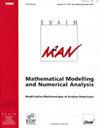网元法的基本收敛理论
IF 1.9
3区 数学
Q2 Mathematics
Esaim-Mathematical Modelling and Numerical Analysis-Modelisation Mathematique et Analyse Numerique
Pub Date : 2021-09-28
DOI:10.1051/m2an/2021062
引用次数: 3
摘要
最近有一篇论文介绍了用离散化网络代替常规网格的网络元法。利用关联网络几何系数,遵循虚拟元框架,提出了一致稳定的数值格式。本文的目的是在适当的假设条件下推导出NEM的收敛理论。我们还得出了基本的误差估计,这是次优的,因为我们必须假设比通常更多的规律性。本文章由计算机程序翻译,如有差异,请以英文原文为准。
Basic convergence theory for the network element method
A recent paper introduced the network element method (NEM) where the usual mesh was replaced by a discretization network. Using the associated network geometric coefficients and following the virtual element framework, a consistent and stable numerical scheme was proposed. The aim of the present paper is to derive a convergence theory for the NEM under mild assumptions on the exact problem. We also derive basic error estimates, which are sub-optimal in the sense that we have to assume more regularity than usual.
求助全文
通过发布文献求助,成功后即可免费获取论文全文。
去求助
来源期刊

CiteScore
2.70
自引率
5.30%
发文量
27
审稿时长
6-12 weeks
期刊介绍:
M2AN publishes original research papers of high scientific quality in two areas: Mathematical Modelling, and Numerical Analysis. Mathematical Modelling comprises the development and study of a mathematical formulation of a problem. Numerical Analysis comprises the formulation and study of a numerical approximation or solution approach to a mathematically formulated problem.
Papers should be of interest to researchers and practitioners that value both rigorous theoretical analysis and solid evidence of computational relevance.
 求助内容:
求助内容: 应助结果提醒方式:
应助结果提醒方式:


